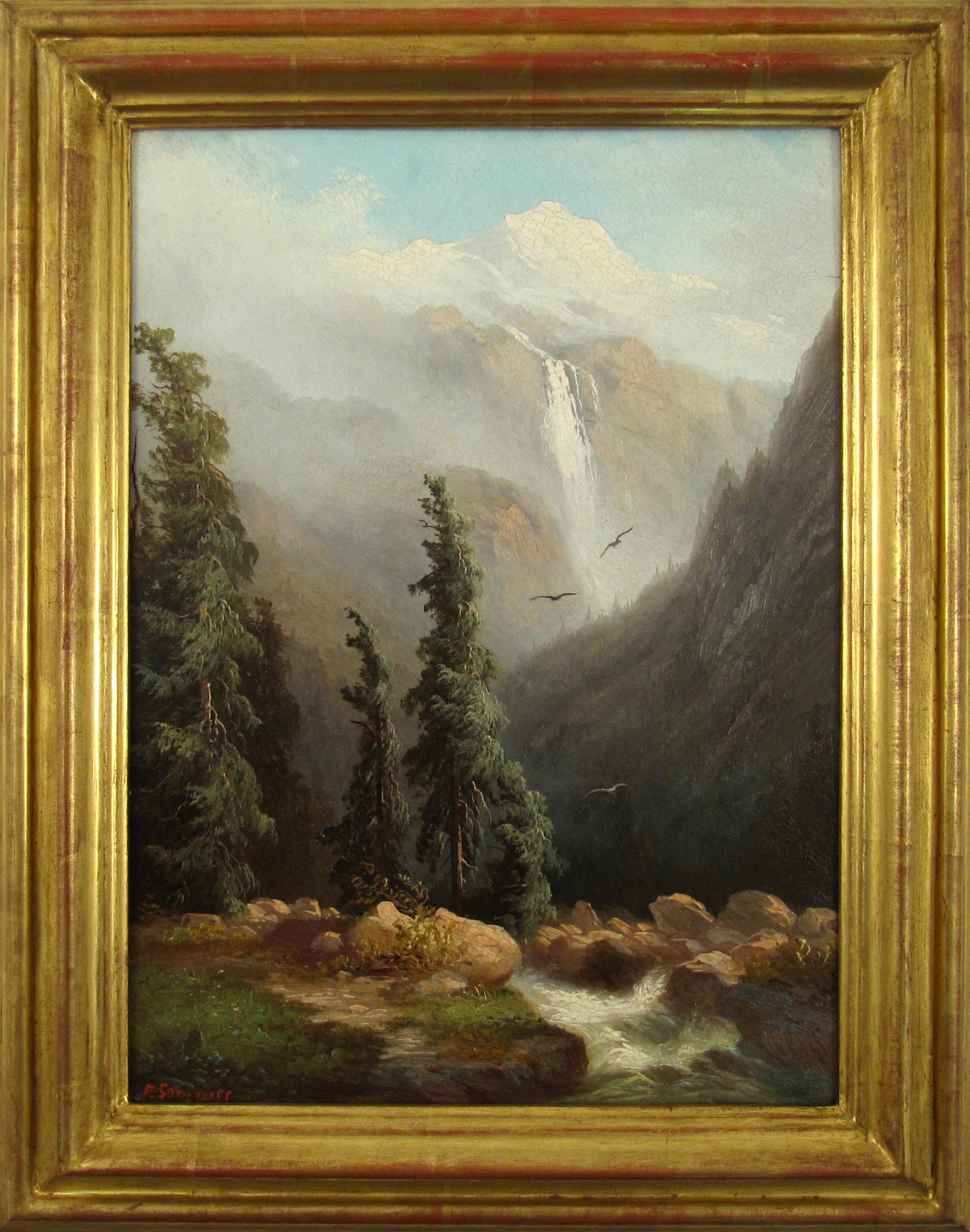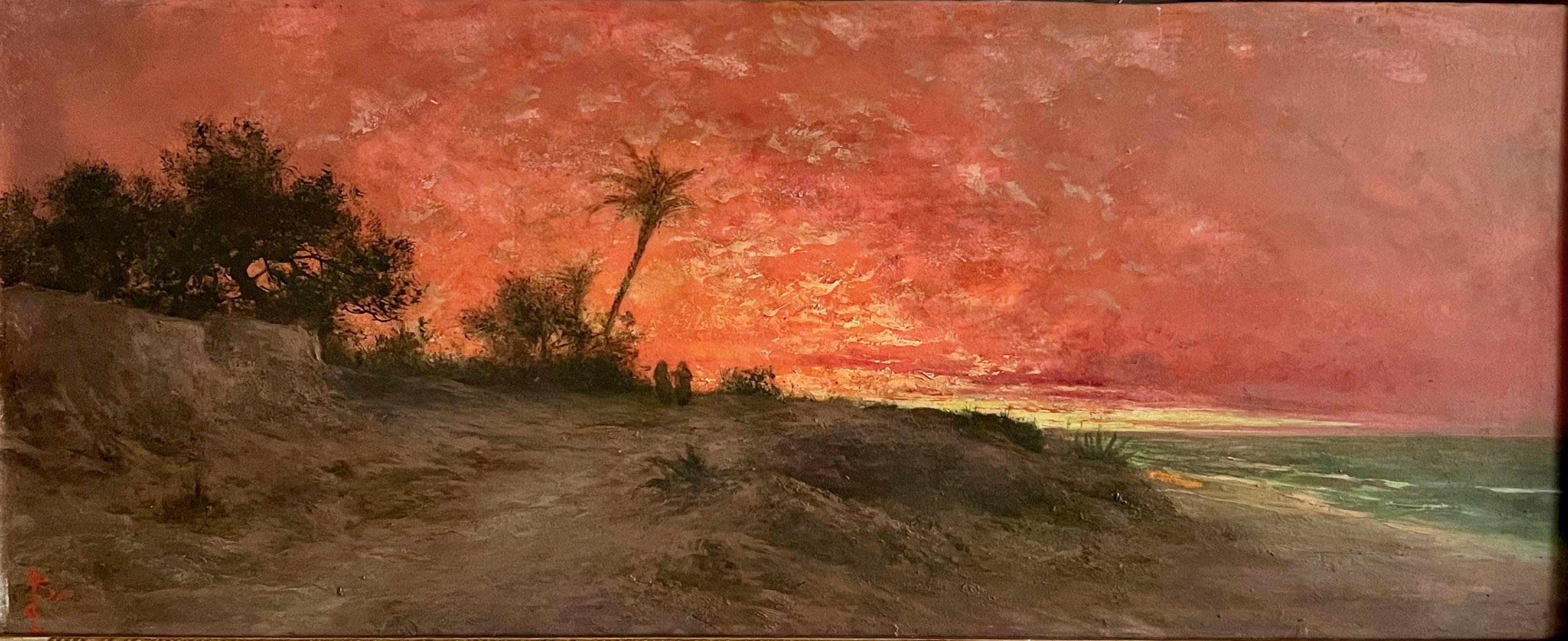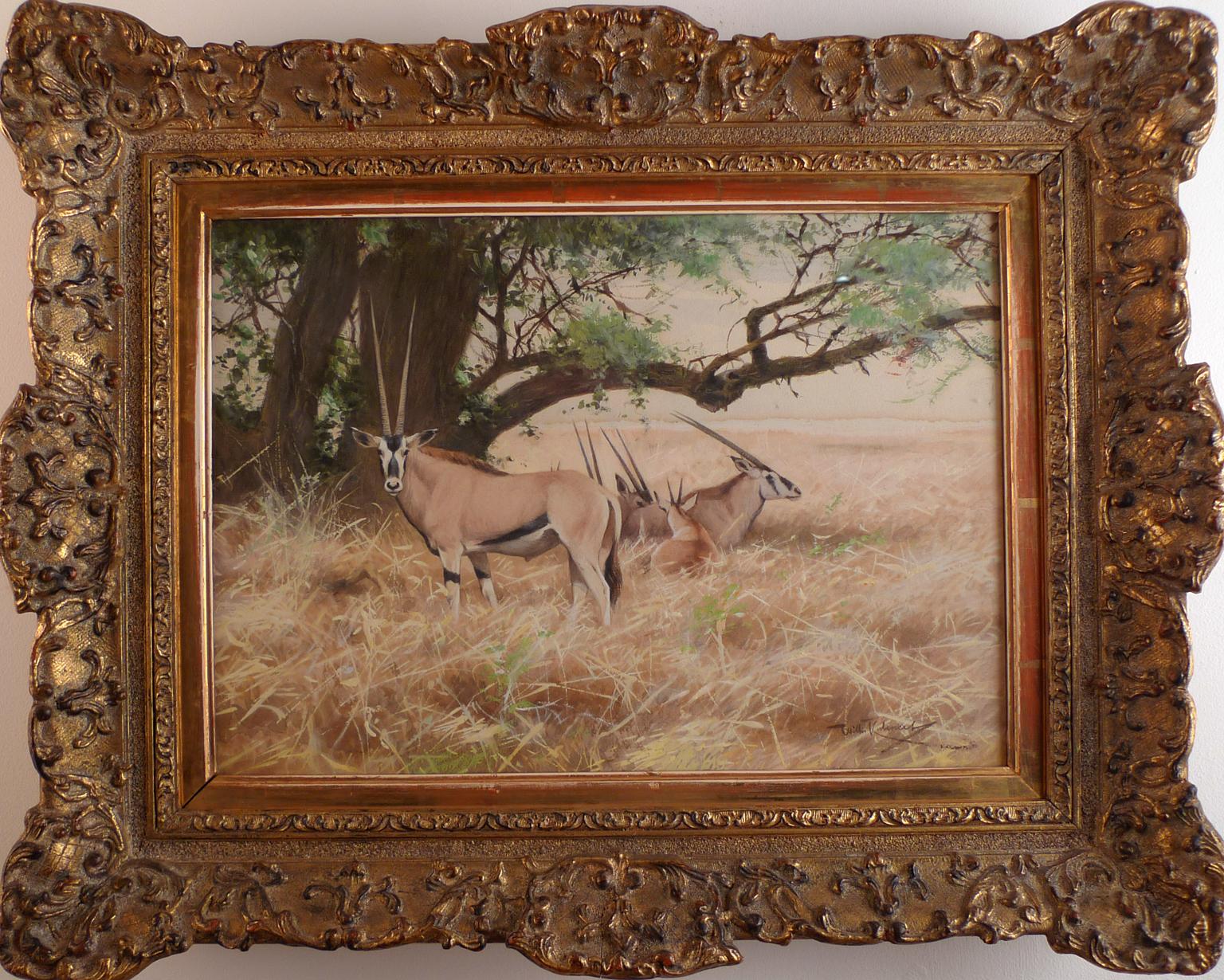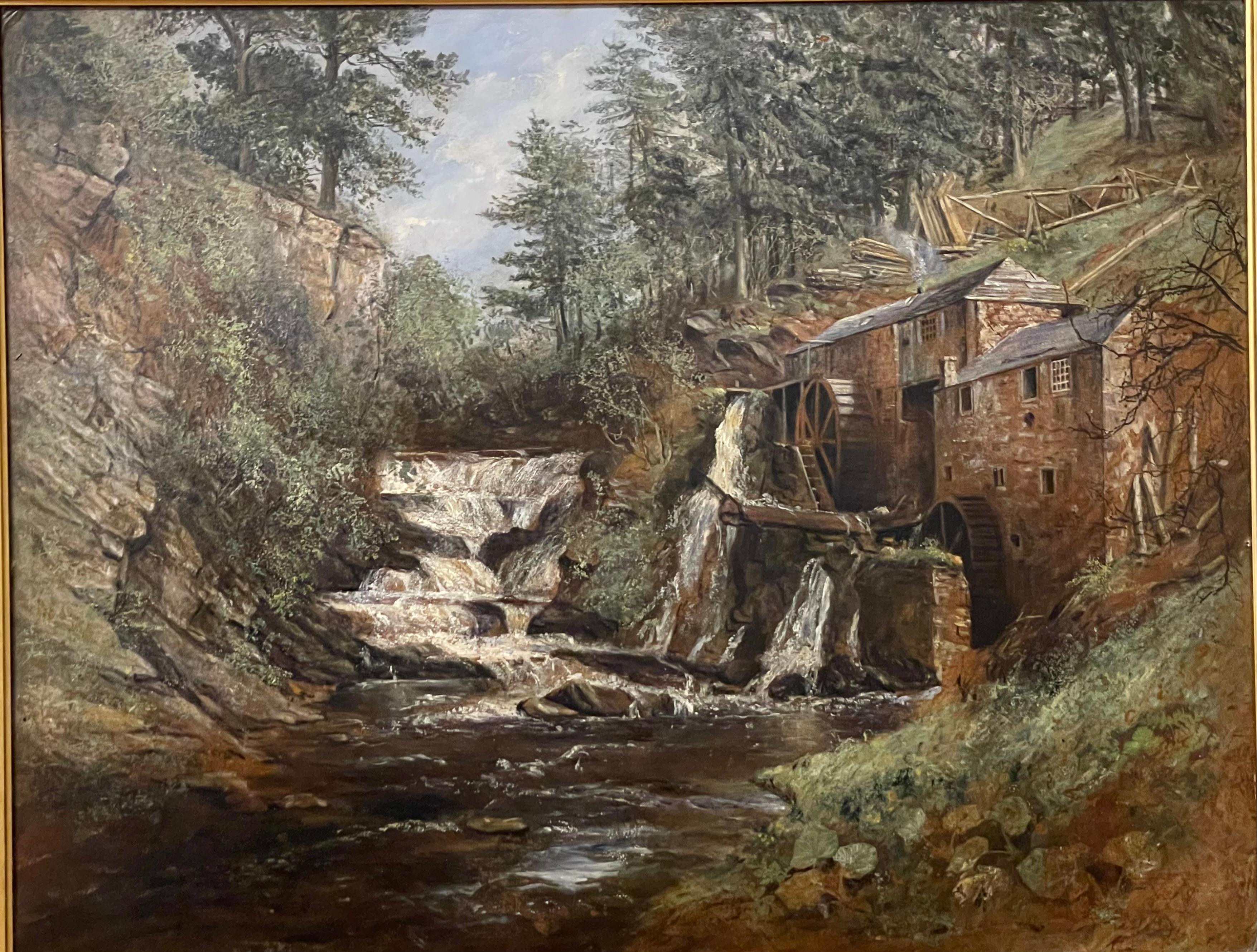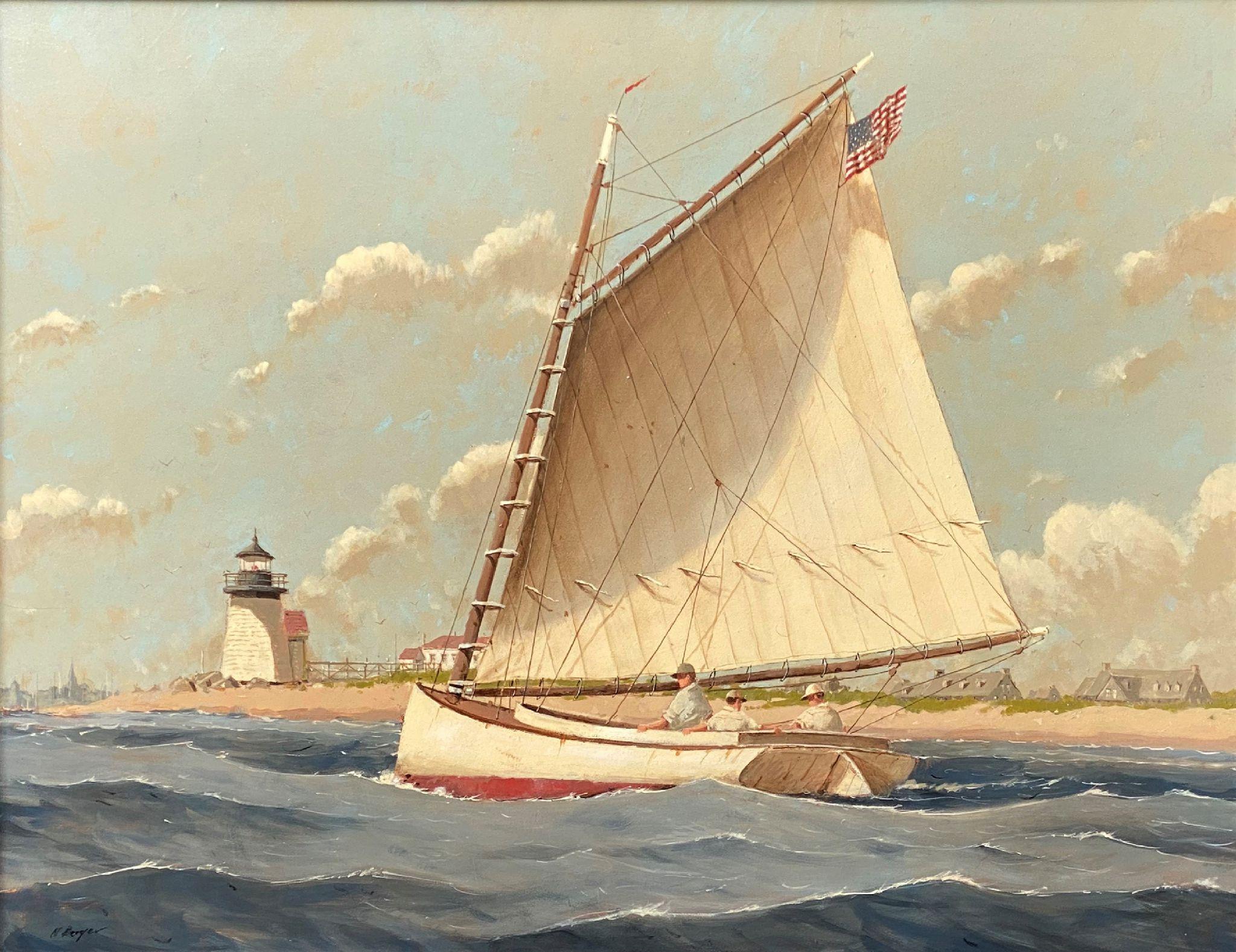Items Similar to Sunny woodland path - A brightly lit forest path as a space for imagination -
Video Loading
Want more images or videos?
Request additional images or videos from the seller
1 of 6
Wilhelm SchützeSunny woodland path - A brightly lit forest path as a space for imagination -around 1880
around 1880
About the Item
Wilhelm Schütze (1840 Kaufbeuren - 1898 Munich). Forest path. Oil on painting board, 30 x 24 cm (visible size), 31 x 26 cm (frame), signed lower left "Wilhelm Schütze".
About the artwork
Pausing in the curve of a path, the viewer looks out over a wooded landscape. But instead of being able to visually delve into the details of the scenery, the near-sighted gaze encounters the materiality of the individual areas of colour that make up the pictorial representation. This does not, however, lead to a dissolution of the pictorial objects through colour. On the contrary, the specific liveliness of the woodland detail is nourished by the virtuoso, partially layered application of paint, whereby the visible brushstroke preserves the movement of its setting and activates it for the pictorial effect.
The landscape, painted in situ, is confined to the background of the painting, giving it an intimate quality. It is painted in a reduced, rather dark palette, characteristic of the Barbizon School, whose artists worked with light by means of dark colours and did not, as in late Impressionism, dissolve it in colour, thus negating it as a means of design. The charm of the picture lies in the contrast between the conifers on the left of the path, which are darkened to green-black, and the light that shines brightly in the sand of the path.
About the artist
Wilhelm Schütze studied under the Hungarian painter Alexander (Sándor) Wagner at the Munich Academy from 1859 and then lived in Munich as a freelance painter. He became known for his sensitive and humorous scenes of children in rural settings and for his landscape paintings.
"His faces and clothes are softly modelled, and his overall colouring is warm, subdued, yet luminous. In terms of painting technique, he is one of the best representatives of the 'Munich School of Painting' [...]".
Selection of public collections that own works by Wilhelm Schütze:
Neue Pinakothek München, Städtische Kunstsammlung Chemnitz.
Selected Bibliography
Friedrich von Boetticher: Malerwerke des neunzehnten Jahrhunderts. Beitrag zur Kunstgeschichte, Bd. 2, Hälfte 2: Saal - Zwengauer, Dresden 1901 (Nachdruck: Hofheim am Taunus, 1979).
Ulrich Thieme, Felix Becker: Allgemeines Lexikon der bildenden Künstler von der Antike bis zur Gegenwart, Bd. 30, Leipzig 1936, S. 319.
Horst Ludwig: Münchner Maler im 19. Jahrhundert. Bd. 4: Saffer - Zwengauer, München 1983, S. 118-121.
Thank you for your interest! I hope I have been able to explain to you the special character of the artwork. If you have any questions of any kind, please feel free to contact me.
I wish you many more discoveries in the realm of art,
Dr Martin Kirves
GERMAN VERSION
Wilhelm Schütze (1840 Kaufbeuren - 1898 München). Waldweg. Öl auf Malpappe, 30 x 24 cm (Innenmaß), 31 x 26 cm (Rahmen), links unten signiert "Wilhelm Schütze".
zum Werk
In der Ausbuchtung einer Wegbiegung innehaltend, blickt der Betrachter auf eine Waldlandschaft. Doch anstatt sich visuell in die Details der Szenerie hinein vertiefen zu können, stößt der nahsichtige Blick auf die Materialität der einzelnen Farbflächen, aus denen sich die bildliche Darstellung zusammensetzt. Dies führt jedoch nicht zu einer Auflösung der Bildgegenstände durch die Farbe. Ganz im Gegenteil speist sich die spezifische Lebendigkeit des Waldausschnitts aus dem virtuosen, teilweise übereinander geschichteten Farbauftrag, wobei der sichtbare Pinselduktus die Bewegung seiner Setzung bewahrt und für die Bildwirkung aktiviert.
Die sicherlich in situ entstandene, nach hinten begrenzte und dadurch intim wirkende Landschaft ist in einer reduzierten, eher dunkeltonigen Palette gehalten, wie sie für die Schule von Barbizon kennzeichnend ist, deren Künstler vermittels der dunkeltonigen Farben mit dem Licht arbeiten und es nicht - wie der späte Impressionismus - in Farbe auflösen und dadurch als Gestaltungsmittel negieren. Der Reiz des Bildes liegt gerade in dem kontrastreichen Zusammenspiel zwischen dem sich beim Nadelgehölz am linken Wegesrand bis ins Grünschwarze verdunkelnden Baumbestandes und dem im Sand des Weges hell aufscheinenden Licht.
zum Künstler
Wilhelm Schütze studierte ab 1859 bei dem ungarischen Maler Alexander (Sándor) Wagner an der der Münchner Akademie und war anschließend als freier Maler in München ansässig. Bekannt wurde er für seine einfühlsam humorvollen Kinderszenen im ländlichen Milieu und für seine Landschaftsdarstellungen.
„Weich modelliert er Gesichter und Kleider, malerisch ist sein Gesamtkolorit in warmen, abgetönten, aber dennoch leuchtenden Farben. Maltechnisch gehört er mit zu den besten Vertretern der „Münchner Malerschule" [...].“
Auswahl öffentlicher Sammlungen, die Werke von Wilhelm Schütze besitzen:
Neue Pinakothek München, Städtische Kunstsammlung Chemnitz.
Auswahlbibliographie
Friedrich von Boetticher: Malerwerke des neunzehnten Jahrhunderts. Beitrag zur Kunstgeschichte, Bd. 2, Hälfte 2: Saal - Zwengauer, Dresden 1901 (Nachdruck: Hofheim am Taunus, 1979).
Ulrich Thieme, Felix Becker: Allgemeines Lexikon der bildenden Künstler von der Antike bis zur Gegenwart, Bd. 30, Leipzig 1936, S. 319.
Horst Ludwig: Münchner Maler im 19. Jahrhundert. Bd. 4: Saffer - Zwengauer, München 1983, S. 118-121.
Vielen Dank für Ihr Interesse! Ich hoffe, ich habe Ihnen den besonderen Charakter des Kunstwerks näherbringen können. Bei Fragen jeglicher Art können Sie mich gerne kontaktieren.
Ich wünsche Ihnen noch viele Entdeckungen im Reich der Kunst,
Dr. Martin Kirves
- Creator:Wilhelm Schütze (1840 - 1898, German)
- Creation Year:around 1880
- Dimensions:Height: 11.82 in (30 cm)Width: 9.45 in (24 cm)
- Medium:
- Movement & Style:
- Period:
- Condition:
- Gallery Location:Berlin, DE
- Reference Number:1stDibs: LU2438211896812

About the Seller
5.0
Vetted Seller
These experienced sellers undergo a comprehensive evaluation by our team of in-house experts.
Established in 2014
1stDibs seller since 2023
7 sales on 1stDibs
Typical response time: 7 hours
- ShippingRetrieving quote...Ships From: Berlin, Germany
- Return PolicyA return for this item may be initiated within 14 days of delivery.
More From This SellerView All
- Autumn Landscape in Sunlight - Indian Summer -Located in Berlin, DEFrederick Vezin (1859 Torresdale Philadelphia - 1933 Düsseldorf), Autumn Landscape in the Sunlight, oil on canvas, mounted on cardboard, 32 x 41 cm (inside measurement), 44 x 51 cm (...Category
Early 1900s Impressionist Landscape Paintings
MaterialsOil, Cardboard
- Low Mountain Landscape with Rocks - The mystery of an inconspicuous place -Located in Berlin, DEHeinz Roder (1895-1965), Low Mountain Landscape with Rocks, oil on painting cardboard, 30 x 40 cm (visual size), 40 x 50 cm (frame), signed and dated "[19]34" at lower right. In a de...Category
1930s Landscape Paintings
MaterialsCardboard
- Landscape with Trees by a Lake - Eternal summer silence over an abysmal lake -Located in Berlin, DEAndreas Thomas Juuel (1816 Copenhagen - 1868 Copenhagen). Summer landscape with tall deciduous trees by a lake. Oil on canvas, 54,5 x 42 cm (visible size), 71 x 58 cm (frame), signed...Category
1850s Realist Landscape Paintings
MaterialsOil
- Children with geese in the light of a summer eveningLocated in Berlin, DEMagda Kremer (*1942 Hengelo), Children with geese in the light of a summer evening. Oil on canvas, 40 x 50 cm (inside measurement), 52 x 62 cm (frame), signed by hand with "M.[agda] ...Category
Mid-20th Century Realist Figurative Paintings
MaterialsOil
- Two countrywomen with a donkey - Melancholy in an atmosphere of colour -Located in Berlin, DEPierre Louis De La Rive (1753 Geneva - 1817 Geneva). Two countrywomen with a donkey. Oil on canvas, mounted, 27 x 20 cm (visible size), 37 x 31 (frame), monogrammed "P.R." at lower right. About the artwork De La Rive has taken the typical scenes of Dutch landscape genre paintings...Category
1790s Old Masters Figurative Paintings
MaterialsCanvas, Oil
- Late Summer River Landscape / - Realistic Impression -By Jan Hillebrand WijsmüllerLocated in Berlin, DEJan Hillebrand Wijsmuller (1855 Amsterdam - 1925 ibid.), Late Summer River Landscape, oil on canvas, relined, 34 x 56 cm (inside measurement), 43 x 64 cm (frame), signed J[an] H[illebrand] Wijsmuller at lower right. - in good condition, the frame with isolated bumped spots - Realistic Impression - About the artwork The panoramic landscape format shows a river landscape, with the course of the river, which curves to the right, leading the eye into the depths of the picture and tempting it to continue the landscape in the imagination beyond the visible area. At the same time, however, the fact that the landscape is not visible through the bend in the river focuses our gaze on the entirety of the landscape depicted, without prompting us to focus on distant details. Accordingly, the brushstroke is not designed to render details with realistic precision. In the front left area of the river there is even a completely free brushwork, trained by Impressionism, which nevertheless remains committed to representational and convincingly suggests the movement of the water. Regardless of the distance of the observer, the entire picture is painted with the same broad brushstroke, so that the landscape is given as an impression. And yet this impression is not ephemeral, as in the case of French Impressionism, to put it exaggeratedly, but reveals to us the essence of the landscape in all its richness. This is why the Dutch variant of Impressionism is always also a realism, although the pictures appear less progressive, but still contain a dimension of landscape painting that is lost with progress. In the impression, the reality of the landscape is revealed, and this happens as we experience the landscape in the visual impression. Wijsmuller does not depict houses or people in order to allow the experience of the landscape to fully unfold. The experience is determined first and foremost by the river, which does not flow into the picture from our point of view, but towards us. Where the river begins to bend, the water is churned by a rapids. Toward us, the riverbed widens and the water comes to rest, covering the entire width of the foreground like a mirror. The stillness of the water corresponds to the evening mood of the late summer landscape, in which the warm tones of the evening light blend with the yellow and brown tones of the plants. A gentle, almost idyllic reality, carried by the brushstroke, yet animated by a liveliness that is also made visible by the brushstroke. The broad, dynamically placed brushstrokes evoke the movement of the treetops and animate even the immobile reeds, while the trunks on the right bank, executed in virtuoso white strokes that seem like markings, make the sunlight shine. On the other bank, a carpet of light also spreads out, its energetic effect again expressed in the brushstroke. The dynamic of the landscape is further enhanced by the complementary color contrasts between the greens, yellows, and browns on the one hand and the blue of the all-encompassing sky on the other. A contrast that is intensified by the reflection in the water. The evening coming to rest of the landscape is thus at the same time an all-encompassing contrasting and yet in itself harmonious movement. This reality becomes accessible to us as an experience in the impression of the landscape. About the artist Jan Hillebrand Wijsmuller entered the Royal Academy of Arts in Amsterdam in 1876 and studied under the innovative Professor August Allebé, who was famous for the Amsterdam Impressionism, also known as the Allebé School. In 1877, Wijsmuller transferred to the Hague Academy of Art, and thus to the Hague School, and then completed his studies at the Brussels Academy of Art. Returning to the Netherlands, Wijsmuller opened his own studio in Amsterdam. In 1883 he won the prestigious Young Artist Award, donated by Willink van Collen, which made Wijsmuller a well-known and sought-after artist. Wijsmuller was a member of the Societät Arti et Amicitiae Amsterdam and the Pulchri Studio in The Hague. Wijsmuller belongs to the second generation of the Hague School. While Vincent van Gogh described the protagonists of the first generation to his brother Theo as "the great gray people," the second generation, and Wijsmuller in particular, used a much more colorful palette. His oeuvre makes him a major player in Dutch Impressionism...Category
1890s Impressionist Landscape Paintings
MaterialsCanvas
You May Also Like
- Boats at the coast. 1975, cardboard, oil, 37x40 cmLocated in Riga, LVBoats at the coast. 1975, cardboard, oil, 37x40 cm Fishing village by the sea. Painting in blue colors. Сalm harmonious seascapeCategory
1970s Naturalistic Landscape Paintings
MaterialsOil, Cardboard
- Ferdinand Sommer (1822-1901) Lauterbachbrunnental 1880 Swiss Alpine Oil PaintingBy Johann Andreas Ferdinand SommerLocated in Meinisberg, CHFerdinand Sommer (German, * 28.5.1822 Coburg, † 26.7.1901 Luzern) Romantic view of the wild Lauterbachbrunnental with the Schmadribachfall and the Jungfrau Mountain and three circli...Category
Late 19th Century Naturalistic Landscape Paintings
MaterialsCanvas, Oil, Cardboard
- Two Oriental Women Walking Near The Beach and Ocean During Sunset With Red Sky.Located in Stockholm, SEA fine painting depicting an oriental shoreline sunset with red skies and two oriental women walking towards their village by the beach and sea. Oil on cardboard by an unidentified a...Category
Late 19th Century Naturalistic Landscape Paintings
MaterialsOil, Cardboard
- "Nialas at rest", 19th Century watercolour by German painter "Wilhelm Kuhnert"By Wilhelm KuhnertLocated in Madrid, ESWILHELM KUHNERT German, 1865 - 1926 NIALAS AT REST signed "Wilhelm Kuhnert" (lower lright) Watercolour on cardboard 11 X 15-3/8 inches (28 X 39 cm.) framed: 16-1/4 X 20-3/4 inches (41.2X 52.5 cm.) PROVENANCE Private Collection, Munich, Germany Private Spanish Collection, Madrid Friedrich Wilhelm Kuhnert (September 18, 1865 – February 11...Category
1920s Naturalistic Animal Paintings
MaterialsWatercolor, Cardboard
- The Old MillLocated in Hillsborough, NCThe Old Mill is a 19th century oil painting on board by Scottish artist Colin Hunter, (1841-1904). Hunter was a member of the Royal Academy with the title...Category
19th Century Naturalistic Landscape Paintings
MaterialsOil, Board
- Friends (Just the Guys)By Nicholas BergerLocated in Greenwich, CTAmerican, b. 1949 In his more than three decades as an artist, Nicholas Berger (b. 1949) has created an outstanding body of work that continues to evolve and excite viewers. Best known for his industrial, waterfront scenes of New York between 1930-1970, Berger effortlessly captures a period when the technology and landscape of the city was rapidly changing. Although he paints scenes of a bygone era, Berger draws inspiration from the waterfronts near his home in New York’s Hudson River Highlands as well as historical sources in museums. Berger holds BFA and MFA degrees from Alfred University. Earlier in his career, the artist painted representational landscapes rendered in watercolor, a medium in which he achieved great success, sharing a sellout two-person show in Tokyo with Andrew Wyeth. In the mid-2000s, Berger transitioned to his signature industrial scenes of the city, employing oil on panel in a painterly manner influenced by the Hudson River and Brandywine schools...Category
2010s Naturalistic Landscape Paintings
MaterialsOil, Board
